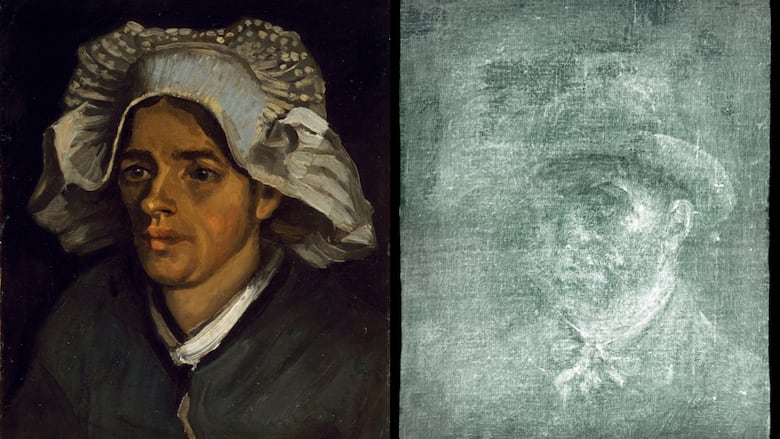This Van Gogh self-portrait was hidden in a Scottish museum for half a century
X-ray revealed the image made on the back of the canvas of the painting Head of a Peasant Woman

Lesley Stevenson didn't expect one of the most exciting moments in her 30-year career as an art conservator to come out of a routine painting examination.
But that's how it happened, as a conservation X-ray revealed a previously unseen self-portrait by Vincent Van Gogh. It was hidden on the back side of a painting sitting in the National Galleries of Scotland's collection for over half a century.
"There it was, staring out at us, very obvious with his straw hat, looking three-quarter profile with his little beard and a characteristic neckerchief," Stevenson, senior paintings conservator at the National Galleries of Scotland, told As It Happens guest host Robyn Bresnahan.
"It was hugely exciting, quite a thrill — and I have to say, instantly recognizable. There was really little doubt who it was."
The self-portrait of the Dutch master was found on the back of an 1885 Van Gogh painting titled Head of a Peasant Woman. It's part of a series of studies the artist did in preparation for his early masterpiece, The Potato Eaters, which is displayed in the Van Gogh Museum in the Netherlands.

"It's very different from the impressionist paintings to which he was exposed when he travelled to Paris two years later," Stevenson said of Van Gogh's study.
Edinburgh lawyer Alexander Maitland gifted Peasant Woman to the NGS collection in 1960, in memory of his wife Rosalind.
The latest discovery dates back to a formative period in Van Gogh's artistic career after his arrival in Paris in the late 1800s, where he started experimenting with self-portraiture and more expressive styles of painting.
"Moving from The Potato Eaters to Paris was quite a significant moment — quite a transition for him stylistically," Stevenson said.
Since Van Gogh often struggled to get money for new art supplies, he reused many of his canvases.
"There are a number of these self-portraits that he carried out on the back of these earlier Dutch studies that he completed in 1885 in Nuenen in the Netherlands," Stevenson said.
Portrait on the front, self-portrait at the back
The self-portrait is covered by layers of glue and cardboard, and its location is somewhat unusual, Stevenson explained. "We're used to finding images underneath earlier compositions by the same artist" through X-ray analysis, she said.
"But in this instance, the painting is actually on the back of the canvas."
The canvas with Head of a Peasant Woman was stuck onto cardboard, which made the self-portrait at the back more difficult to access. Experts at the NGS believe the cardboard and glue were applied ahead of an exhibition in the early 20th century, since Peasant Woman was considered more finished than the self-portrait.
Stevenson said that her team of specialists are now exploring how to uncover the later work without damaging the painting.
"It's a fairly straightforward process, removing cardboard. But then we will come across a very degraded glue layer on top of the Van Gogh self-portrait. So we will have to undertake very careful investigations as to how we remove the glue without putting the paint film at any risk."
Art enthusiasts can view Van Gogh's Head of a Peasant Woman, along with the X-ray image of the self-portrait, at the Royal Scottish Academy's A Taste for Impressionism exhibit in Edinburgh. The exhibition runs from July 30 to Nov. 13.
Written by Olsy Sorokina. Interview with Lesley Stevenson produced by Arman Aghbali.
